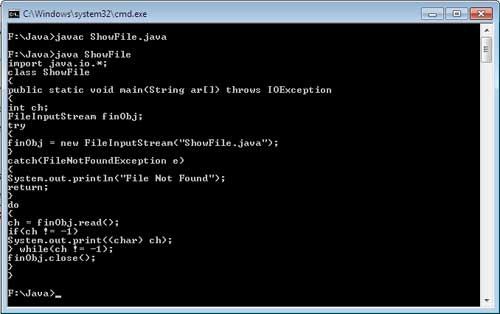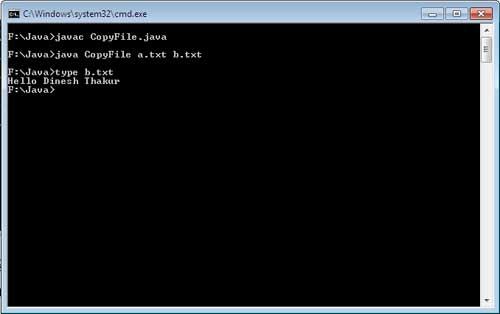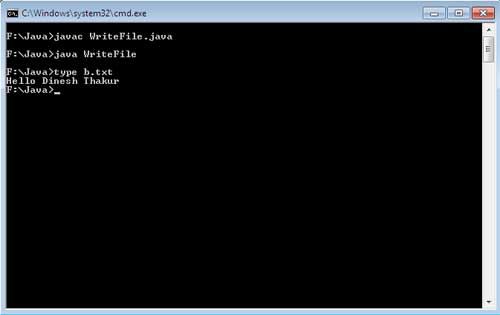Java makes available a set of classes and methods that allows you to read from and write to files. Java supports both streams and methods to read from and write to file respectively.
Example: Read file using FilelnputStream
import java.io.*;
class ShowFile
{
public static void main(String ar[]) throws IOException
{
int ch;
FileInputStream finObj;
try
{
finObj = new FileInputStream(“ShowFile.java”);
}
catch(FileNotFoundException e)
{
System.out.println(“File Not Found”);
return;
}
do
{
ch = finObj.read();
if(ch != -1)
System.out.print((char) ch);
} while(ch != -1);
finObj.close();
}
}
Output

Print contents of own source file, read character by character and write character by character.
Example: Read file using FileReader
import java.io.*;
class FileRead
{
public static void main(String arg[]) throws IOException
{
FileReader frObj = new FileReader(“FileRead.java”);
BufferedReader brObj = new BufferedReader(frObj);
String str;
while ((str = brObj.readLine ())!=null)
System.out.println(str);
frObj.close();
}
}
Output

Read the file content line by line, and print in the same manner.
Example: Writing data using FileOutputStream
import java.io.*;
class CopyFile
{
public static void main(String arg[]) throws IOException
{
int i;
FileInputStream finObj;
FileOutputStream foutObj;
try
{
try
{
finObj = new FileInputStream(arg[0]);
}
catch(FileNotFoundException e)
{
System.out.println(“File ” + arg[0] + ” not Found”);
return;
}
try
{
foutObj = new FileOutputStream(arg[1]);
}
catch(FileNotFoundException e)
{
System.out.println(“File” +arg[1]+” not found”);
return;
}
}
catch(ArrayIndexOutOfBoundsException e)
{
System.out.println(“Argument missing”);
return;
}
try
{
do
{
i = finObj.read();
if(i != -1)
foutObj.write(i);
}while(i != -1);
}
catch(IOException e)
{
System.out.println(“Some file error occurd”);
}
finObj.close();
foutObj.close();
}
}
Output:

Copy content of a.txt to b.txt
It is clear form the output window given above that content of a.txt has been copied to b.txt.
Example: Writing data using FileWriter
import java.io.*;
public class WriteFile
{
public static void main(String[] args) throws IOException
{
File inputFileObj = new File(“a.txt”);
File outputFileObj = new File(“b.txt”);
FileReader finObj = new FileReader(inputFileObj);
FileWriter foutObj = new FileWriter(outputFileObj);
int c;
while ((c = finObj.read()) != -1)
foutObj.write(c);
finObj.close();
foutObj.close();
}
}
Output:

Copy content of a.txt to b.txt
 Dinesh Thakur holds an B.C.A, MCDBA, MCSD certifications. Dinesh authors the hugely popular
Dinesh Thakur holds an B.C.A, MCDBA, MCSD certifications. Dinesh authors the hugely popular